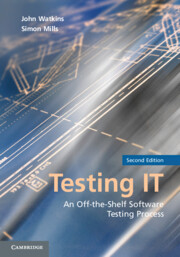Book contents
- Frontmatter
- Contents
- Foreword to the Second Edition by Geoff Thompson
- Foreword to the First Edition by Maurice Rosenburgh
- Acknowledgments
- 1 Introduction
- PART 1 THE TRADITIONAL TESTING PROCESS
- 2 An Overview of Testing
- 3 Testing Techniques
- 4 The Management and Planning of Testing
- 5 Unit Testing
- 6 Integration Testing
- 7 System Testing
- 8 Systems Integration Testing
- 9 User Acceptance Testing
- 10 Operations Acceptance Testing
- 11 Regression Testing
- 12 Improving the Testing Process
- 13 Introduction, Adoption, and Maintenance of the Testing Process
- 14 Agile Testing
- PART 2 THE TESTING PROCESS IN THE REAL WORLD: ILLUSTRATIVE CASE STUDIES
- PART 3 THE APPENDICES
- References
- Glossary
- Index
9 - User Acceptance Testing
Published online by Cambridge University Press: 03 May 2011
- Frontmatter
- Contents
- Foreword to the Second Edition by Geoff Thompson
- Foreword to the First Edition by Maurice Rosenburgh
- Acknowledgments
- 1 Introduction
- PART 1 THE TRADITIONAL TESTING PROCESS
- 2 An Overview of Testing
- 3 Testing Techniques
- 4 The Management and Planning of Testing
- 5 Unit Testing
- 6 Integration Testing
- 7 System Testing
- 8 Systems Integration Testing
- 9 User Acceptance Testing
- 10 Operations Acceptance Testing
- 11 Regression Testing
- 12 Improving the Testing Process
- 13 Introduction, Adoption, and Maintenance of the Testing Process
- 14 Agile Testing
- PART 2 THE TESTING PROCESS IN THE REAL WORLD: ILLUSTRATIVE CASE STUDIES
- PART 3 THE APPENDICES
- References
- Glossary
- Index
Summary
“If love is like an extended software Q.A. suite, then true love is like a final Acceptance Test – one often has to be willing to endure compromise, bug fixes and work-arounds; otherwise, the software is never done.”
– The Usenet OracleOverview
The objective of user acceptance testing is to confirm that the application under test (AUT) meets its business requirements and to provide confidence that the system works correctly and is usable before it is formally “delivered” to the end user(s). User acceptance testing is conducted by one or more user representatives with the assistance of the test team.
User acceptance testing is considered distinct from operations acceptance testing, which is used to verify the operations and administrative aspects of the AUT (e.g., the installation of updates to the AUT, back-up, archive, and restoring the AUT and its data, and the registration of new users and assigning of their privileges). In practice, where the AUT supports simple administrative facilities, user and operations acceptance testing are often combined into a single testing exercise. Also see Chapter 10 – Operations Acceptance Testing.
User acceptance testing should employ a black box approach to testing and should make use of thread testing techniques to verify the high-level business requirements of the system. In practice, the user representative(s) will test the AUT by performing typical tasks they would perform during normal usage of the system.
User acceptance testing should also address testing of system documentation (such as user guides) by the user representative(s).
- Type
- Chapter
- Information
- Testing ITAn Off-the-Shelf Software Testing Process, pp. 77 - 83Publisher: Cambridge University PressPrint publication year: 2010



